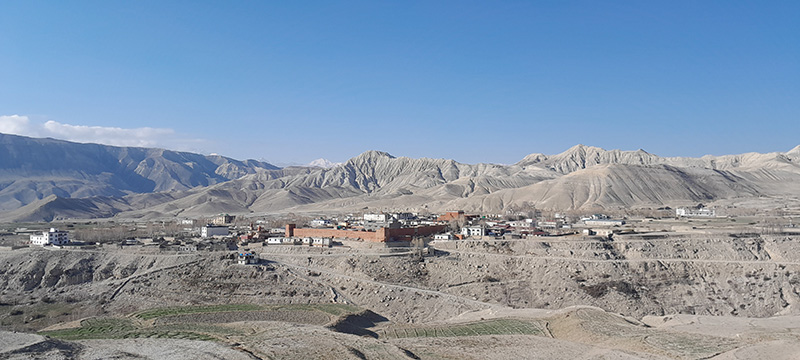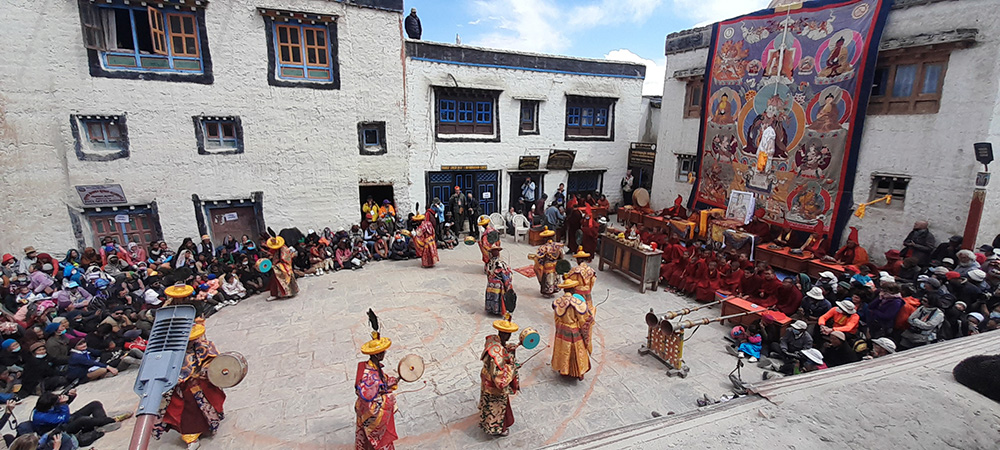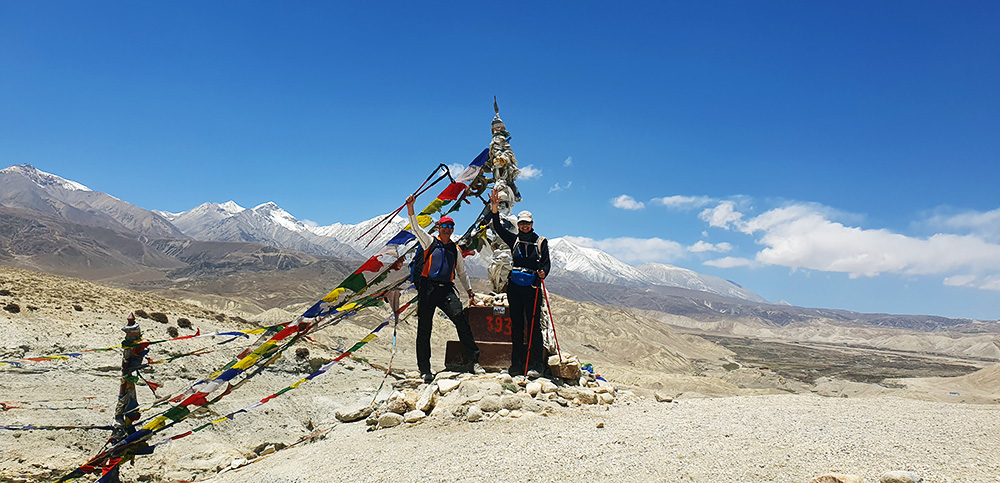The Tiji Festival is one of the most auspicious and culturally significant festivals celebrated in Nepal's Upper Mustang region. It was rooted in ancient mythology, talking about the victory of good over evil, which deeply appeals to the sentiments of the local Tibetan Buddhists. According to the legend, the land was plagued by destructive monsters that spread disease and drought until it was conquered by the god Dorje Jono, which resulted in the soil returning to its peaceful and prosper state. And do so with prayer songs.
Dorje Jono, better known as Dorje Phurba, Vajrakila, or Vajrakumara, is the name of a deity in Vajrayana Buddhism. This tradition originally came from India and Nepal. This cult performed, in the 8th century, the rituals of maturity with the people, but soon other dynasties were established. These are more generally known, including the Vajra Kila ritual dance, one of the most important ones within this tradition, still enacted in modern times in the Tizi festivals.
This ritual has its grounding in history to be precise: Samay monasteries in Tibet, where Padmasambhava The Vajrakila has laid down very specific instructions regarding ritual dances, and Chhod Monastery is well-known for showing off this ritual skills in Lo Manthang, the capital of Upper Mustang in the 17th century when King Samadup Rabten of Mustangi invited the Trijin Ngawang Kunga to be tattooed. He came to perform the Vajrakila ritual to purify this land in order to bring prosperity to the people of Mustang. The festival is a three-day ground event in the grounds of the Mustang Palace in Lo Manthang. Traditionally, it takes place at the end of the 12th month of the Tibetan calendar. And now it takes place during the 3rd month- generally May. Its quite an important event in the community. Under the custody of the monks of Wat Chod, the dancers and Tsovo take several months to prepare. Tsovo himself goes on a three-month retreat of deep meditation and spiritual preparation.
Tizi is a ritual dance performed at the hub of festivals. It has a lot of symbolic meaning. It traces its origins back to Tantra texts on Vajra Kumara. In Mustang, it is called tenshi. There are two distinct phases-one is a peaceful sequence and the other an affirmation of victory over more problematic negative forces-and the whole ritual consists of three phases. The first part of it has 15 different steps. The main part deals with the construction of the heavenly palace and birth of the gods. insofar as victory over illusory visions is the conclusion, bringing good fortune.
Posture and movement play an essential role in dancing. It is believed that specific postures and steps induce meditation, which helps remove obstacles in life. On the other hand, the successful journey of the soul is believed to take place through faith and reverence in these elaborate rituals. For this reason, the Tiji festival is not an exciting event. Rather, it is a spiritual experience for participants and viewers alike.

The Upper Mustang lies on the border of Tibet. Mustang is a formerly independent kingdom which shares a strong relationship with Tibet in terms of language and culture. From the 15th to the 17th century, Mustang was situated at an important location where it could control the trade between India and the Himalayas. In the late 1700s, Nepal annexed the kingdom, and it became a dependent territory of the Kingdom of Nepal. In the year 2008, the Government of Nepal ordered the cessation of the monarchy. In 2016, the last monarch, Jigme Dorje Palbar Bista, died. The Buddhist kingdom was initiated in the year 1380 by the warrior Ame Pal, who built much of Lo Manthang. Full flex arrangement is done in order to celebrate Tiji Festival in the Upper Mustang.
Upper Mustang lies on the border between Tibet, China and Nepal. The local people of the region have their origins from Tibet. Most of their culture, tradition and way of life are related to that of the Tibetan people. Mustang Tiji Festival is one of the cultural and traditional festivals celebrated by the people here after the customs of the ancestors. It has its belief, style, and value at this celebration in the late forbidden Himalayan kingdom of Lo Manthang.
"Tiji" itself is a short form of "Tempa Chirim," which literally means "prayers for world peace" in the local language. The Tiji Festival is a three-day yearly celebration that occurs in the walled city of Lo Manthang, located in Upper Mustang, Nepal, and is open to the public. The event will be a gathering of thousands of people from the entire region of Mustang, traveling to Lo Manthang as part of this propitious celebration. Not only the locals, but also foreign travelers join in this carnival to witness the beauty of Tiji.
Being a Buddhist kingdom, every village of the Upper Mustang region has centuries-old Buddhist monasteries and stupas. The Tiji Festival of the Upper Mustang Region has a close relation to Buddhism. Ghar Gumba is believed to be the oldest monastery in Upper Mustang. It is believed that Guru Rimpoche, also known as Padmashamvaba, constructed this monastery. He traveled to Tibet through the Upper Mustang region during the 8th century.
Nepal is a multicultural and multiethnic country. People of various castes and groups live together peacefully with each other. They follow different cultures and celebrate different festivals. Festivals are celebrated over a particular reason. According to Ancient Mythology, there was a deity named Dorjo Jono. He was a good man. However, his father was evil who brought fear to the common people by bringing scarcity of water in the isolated region. Then, Dorjo Jono battled against his evil father to stop him from bringing the scarcity of water. Dorjo Jono then killed his evil father and disappeared him away from Mustang. Honoring the legend of Jono, Tiji Festival is celebrated with light colors and dance. The peace, prosperity, and happiness brought by Dorjo Jono is the reason for the celebration of the Tiji Festival.

Many people must be wondering how the Tiji Festival is celebrated. Well, the answer is pretty obvious: people have a blast. Break it into components, and during the Tiji Festival, they pray by chanting mantras. Monks wear traditional attire and chant mantras. They also perform a traditional dance. People wear colored dresses, such as yellow, red, and blue. They decorate the entire place with multicolored flags. The multicolored flags, along with the dress, make the entire surrounding rainbowish.
You get to see the true colors of mutual understanding and prosperity in life by experiencing the Tiji Festival in the Upper Mustang.
According to the legend, during the Tiji Festival, a malevolent demon spread a fatal disease all over this region and an acute shortage of water prevailed. Then, a good person encounters this menacing demon and defeats the ill-intentioned evil. Since then, this festival is being celebrated here in Mustang.
This festival will be celebrated for three days, usually in May, at Lomanthang Upper Mustang. The monks will dance in different colored masks and chant Buddhist mantras. In the place of celebration, there will be a mixed population such as locals, VIPs, foreigners and also the King of Mustang. The monks will rehearse for the dance and practice it more often.
Frist day of Tiji Festival - the monks of Chhode Monastery along with the people will make all the preparation on the first day at the square near the Royal Palace. One of the monks will start the festival with a resonating blast of the Tibetan horn, followed by other instruments played by the Lamas. People will go to the square where a giant Thanka is being displayed on the wall. There, the Lamas will perform their chant and various dance forms. This dance form is known as Tsa Chham and it depicts the story of the fighter Dorje Jono fighting with a demon.
It is believed that these dances have their roots in the 15th century.
On the second day of Tiji Festival, there is also going to be dancing and singing. The name of the dance form on the second day is Nga Chham. In this, the gruesome attempts of the warrior Dorje Jono to introduce malevolent forces into the Buddhist world are depicted. Various forms of dances can be seen, showing how peace and love in the world come from deities in Buddhism. The second day is uniquely important as the festival will show monks attired in colorful robes performing.
On the third day of the Tiji Festival, the monks will perform a dance form called Rha Chham. This dance form will depict a feeling of victory over bad times. The last performance is done in the square that will move out into the open space outside the village. From confined space to open area, one can be exposed to the sound effects of gunfire, explosions, and people undertaking activities with equipment and machinery in the presence of a large crowd.
People of Mustang celebrate Tiji because it is part of their culture passed down for many generations of locals in this region of Nepal. Mustang is an area above the Himalayas with an arid climate. It has an enriching history because it was once a sovereign kingdom. It had close cultural, traditional, and trading links with Tibet. This includes a three-day varsi festival, Tiji, which is considered to be one of the most important parts of their culture and tradition.
It celebrates the victory of good over evil and has a mythological background in which there is a demon by the name of Ma Tam Ru Ta. He caused evil and therefore precipitated drought and famine in the area. The festival commemorates the triumph of a saint named Dorje Jono, who is said to have battled and vanquished a demon.
The Tiji Festival is only recognized within the Mustang region and is not celebrated anywhere else throughout Nepal. This festival is culturally significant to the people of Mustang; thus, several curious tourists visit the country in a quest to learn more about the varied cultural heritage of the region. It provides an avenue for the people of Mustang to come together and celebrate their shared culture and history.
It is an annual three-day event celebrated in Lo Manthang, the region of Upper Mustang in Nepal. Normally, the Festival takes place during the latter part of May or at the beginning of June, depending on the Tibetan lunar calendar. Because of the lunar cycle, the dates of the Festival may fall every year. The date of the Tiji Festival in 2026 falls on the 24th, 25th, and 26th of May.

Tiji Festival Trek is the trek in Upper Mustang during the time of the Tiji Festival. This is a kind of trek that has been customarily prepared in such a way that your exploration wont miss either the natural aspects of the Upper Mustang or the cultural essence of the place, i.e., celebrating the Tiji Festival. You get an exciting opportunity to make your presence worth it. Rush and plan your next Tiji Festival Trek to Upper Mustang this May. The myth of a son saving a region from the bad deeds of his evil father is celebrated on this festival. You all deserve to enjoy life, and one of the best options for your wish is the Tiji Festival trek.
Tiji Festival and Yartung Festival are celebrated in the Mustang district. Having a 3 days celebration time, Most of the peoples make mistakes by saying that Tiji Festival is Yartung Festival. As mentioned earlier Tiji Festival is a three-day celebration during the time before the harvest season starts. With dance celebration, chanting mantras, and wearing traditional attires Tiji Festival is quite a festival. However, Yartung Festival is another important festival celebrated in all parts of Mustang Region especially in Muktinath and Lo Manthang. This one, too, is a three-day-long festivity. The difference that makes Yartung Festival unique, though, is that horse racing, drinking, and dancing are mainstays of the celebration. Yartung means end of summer, and Mela means festival, so Yartung Mela is all about celebrating the good life they lived in summer and welcoming the future with great enthusiasm. Whatever differences may exist between the Tiji and Yartung Festival, both are highly enthusiastically and cooperatively celebrated. Hence, they must be preserved. They are the very sorcerers of commonness and togetherness.
Besides the exploration of the Himalayas and exciting trails in Mustang, participate in the Tiji Festival celebration with locals. It adds intensity to the Tiji Festival celebration you are into, with a vibrant scene of the Himalayas behind.
If you want to find out more about Tiji Festival Upper Mustang or need our assistance for planning your Tiji festival trekking, simply send us an email and we will get back to you right away.
Getaway Nepal Adventure (P.) Ltd
Thamel Kathmandu, Nepal